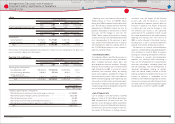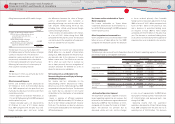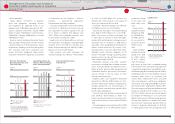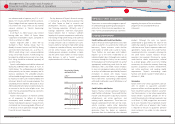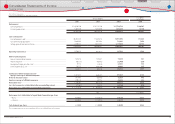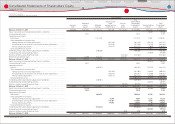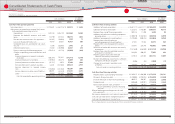Toyota 2010 Annual Report Download - page 61
Download and view the complete annual report
Please find page 61 of the 2010 Toyota annual report below. You can navigate through the pages in the report by either clicking on the pages listed below, or by using the keyword search tool below to find specific information within the annual report.
59
TOYOTA ANNUAL REPORT 2010
Sensitivity analysis
The following table illustrates the eff ects of
assumed changes in weighted-average discount
rate and the weighted-average expected rate of
return on plan assets, which Toyota believes are
critical estimates in determining pension costs
and obligations, assuming all other assumptions
are consistent.
Yen in millions
Eff ect on pre-tax income
for the year ended
March 31, 2011
Eff ect on PBO
as of March 31, 2010
Discount rates
0.5% decrease ···································································· ¥ (10,057) ¥ 127,971
0.5% increase ····································································· 9,603 (118,378)
Expected rate of return on plan assets
0.5% decrease ···································································· ¥ (5,895)
0.5% increase ····································································· 5,895
Derivatives and Other Contracts at Fair Value
Toyota uses derivatives in the normal course
of business to manage its exposure to foreign
currency exchange rates and interest rates. The
accounting is complex and continues to evolve.
In addition, there are signifi cant judgments
and estimates involved in the estimating of fair
value in the absence of quoted market values.
These estimates are based upon valuation
methodologies deemed appropriate under the
circumstances. However, the use of diff erent
assumptions may have a material eff ect on the
estimated fair value amounts.
Marketable Securities and Investments in
Affi liated Companies
Toyotas accounting policy is to record a write-
down of such investments to net realizable value
when a decline in fair value below the carrying
value is other-than-temporary. In determining
if a decline in value is other-than-temporary,
Toyota considers the length of time and the
extent to which the fair value has been less
than the carrying value, the fi nancial condition
and prospects of the company and Toyotas
ability and intent to retain its investment in the
company for a period of time suffi cient to allow
for any anticipated recovery in fair value.
Deferred Tax Assets
Toyota estimates whether future taxable income
is suffi cient at a particular tax-paying component
and records valuation allowances to reduce
deferred tax assets when it is more likely than
not that a tax benefi t will not be realized in the
future periods. Actual taxable income may diff er
from the estimated amounts due to various
assumptions used to estimate future taxable
income. If additional valuation allowance is
recorded due to lower actual taxable income
than estimated amounts it would negatively
aff ect future operating results.
Toyota is exposed to market risk from changes
in foreign currency exchange rates, interest rates,
certain commodity and equity security prices. In
order to manage the risk arising from changes
in foreign currency exchange rates and interest
rates, Toyota enters into a variety of derivative
fi nancial instruments.
A description of Toyotas accounting policies
for derivative instruments is included in note 2
to the consolidated fi nancial statements and
further disclosure is provided in notes 20 and 21
to the consolidated fi nancial statements.
Toyota monitors and manages these fi nancial
exposures as an integral part of its overall risk
management program, which recognizes the
unpredictability of fi nancial markets and seeks
to reduce the potentially adverse eff ects on
Toyotas operating results.
The fi nancial instruments included in the
market risk analysis consist of all of Toyotas cash
and cash equivalents, marketable securities,
fi nance receivables, securities investments, long-
term and short-term debt and all derivative
fi nancial instruments. Toyotas portfolio of
derivative fi nancial instruments consists of
forward foreign currency exchange contracts,
foreign currency options, interest rate swaps,
interest rate currency swap agreements and
interest rate options. Anticipated transactions
denominated in foreign currencies that are
covered by Toyotas derivative hedging are not
included in the market risk analysis. Although
operating leases are not required to be included,
Toyota has included these instruments in
determining interest rate risk.
Foreign Currency Exchange Rate Risk
Toyota has foreign currency exposures related to
buying, selling and fi nancing in currencies other
than the local currencies in which it operates.
Toyota is exposed to foreign currency risk related
to future earnings or assets and liabilities that are
exposed due to operating cash fl ows and various
fi nancial instruments that are denominated in
foreign currencies. Toyotas most signifi cant
foreign currency exposures relate to the U.S.
dollar and the euro.
Toyota uses a value-at-risk analysis (VAR)
to evaluate its exposure to changes in foreign
currency exchange rates. The VAR of the
combined foreign exchange position represents
a potential loss in pre-tax earnings that was
estimated to be ¥114.1 billion as of March 31,
2009 and ¥148.9 billion as of March 31, 2010.
Based on Toyotas overall currency exposure
(including derivative positions), the risk during
the year ended March 31, 2010 to pre-tax cash
fl ow from currency movements was on average
¥135.5 billion, with a high of ¥148.9 billion and a
low of ¥123.8 billion.
The VAR was estimated by using a Monte
Carlo Simulation Method and assumed 95%
confi dence level on the realization date and a
10-day holding period.
Interest Rate Risk
Toyota is subject to market risk from exposures
to changes in interest rates based on its
fi nancing, investing and cash management
activities. Toyota enters into various fi nancial
instrument transactions to maintain the desired
level of exposure to the risk of interest rate
Market risk disclosures
Financial Section
Financial Section
Investor Information
Corporate Information
Special Feature
Consolidated
Performance Highlights
Business Overview
Top Messages
Management's Discussion and Analysis of
Financial Condition and Results of Operations


